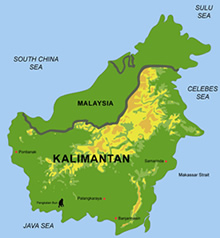remote sensing

our work
kalteng remote sensing shows trends in environments like Kalimantan.
- TanDEM-X elevation model data for canopy height ...
- Monitoring Forest Threats with C- and L-band SAR, ...
- Ground Penetrating Radar Mapping of Peat ...
- Spectral Variability and Discrimination ...
- Kalteng Consultants Company Profile, Oct
- Visiting of Wetlands International Camp on ...
- Ortho Photo Mosaik von Kelurahan Tumbang Tahai ...
- Ortho-Photo Mosaik from Lake Batu, north of ...
- International Symposium & Workshop on Tropical ...
- The Contribution of CHRIS/PROBA Data for Tropical ...
- Workshop on Spatial Planning and new Remote ...
- Ortho-Photo Generation and Mosaiking of City ...
- Ortho-Photo Mosaik from Kecamatan Bukit Batu, ...
- International Workshop, Wild Fire and Carbon ...
- Planning Group for Kecamatan Bukit Batu gathered ...
- Carbon Storage in the Northern Sabangau Area ...
- Peat Land Topography derived from 30m Resolution ...
- Peat depth, minerals below peat, carbon, fires ...
- Carbon Storage in the Northern Sebangau Area ...
- Peatland Topography DEM-measurements with ...
- Precise Measurements of Peatland Topography and ...
- Environmental Management Study of the Tangkiling ...
- Environmental Field Trials and GIS Image ...
- Land Cover Change on Peatland in Kalimantan ...
- The Impact of Logging and Land Use Change in ...
- Tracks along the Kalimantan Highway from Kasongan ...
- Fires in 2002 monitored on the Landsat-images 14 ...
- The Amount of Carbon released from Peat and ...
- Land use Change in Central Kalimantan over the ...
- Remote Sensing and Aerial Survey of Vegetation ...
- Monitoring land cover and impacts, Remote Sensing ...
- Fire Impacts and Carbon Release on Tropical ...
- Ecological Impact of the one Million Hectare Rice ...
- Land Use Change and (Il)-Legal Logging in Central ...
- Peat fires in Central Kalimantan, Indonesia: Fire ...
- Environmental Helicopter Flight Trails with ...
- Impact of the 1997 Fires on the Peatlands of ...
- Application of Remote Sensing and GIS to monitor ...
- Monitoring of 1997/1998 Fires and Burnt Scars in ...
- Flight survey over the Mega Rice Project and over ...
- Application of Remote Sensing and GIS to survey ...
- Mega Rice Project in Central Kalimantan, ...
- Satellite Images and Aerial Photos from the ...
- The need for better
- Remote Sensing Verification by Aerial Surveys and ...
- NATURAL RESOURCE FUNCTIONS, BIODIVERSITY AND ...
- Excursion to Central Kalimantan, ...
- Satellite Images and Aerial Photography’s from ...
- Symposium of International Peat Society, ...
- Indonesia Travel to Jakarta, Bali and Kalimantan ...
- The Mega Rice Project Central Kalimantan ...
- Land Use Planning and Environmental Monitoring in ...
- Bildverarbeitung von Sensorbildern zur Erstellung ...
- GIS-Workshop, Camp km48 Sangai.
- Monitoring Land Use Change on Tropical Peatland ...
- Seminar on Scientific Implications of the ...
- Report of Ground Truth Campaigns incl. Aerial ...
- Ground and Helicopter verification of Satellite ...
- Environmental Detection from Satellite and ...
- First visit to Central Kalimantan in June 1995, ...
- Environmental Helicopter with Modular Sensor ...
- Remote Sensing with a Thermal Imager on an ...
- The Use of an Environmental Helicopter for the ...
- EUROMAR-SEASTARS a Modular Multi-Sensor System ...
gallery

image gallery
Find a large collection of images from many years of exploration by kalteng-consultants.
History Borneo - Kalimantan · Excursions to peatland 1996 · Mega Rice Project 1999 · 2004 · 2005 · 2006 · 2007 · 2008 · 2009 · 2010 · 2011 · 2012 · 2013 · 2014 · 2015 · 2016-March · 2016-August ·
remote sensing
Peat fires in Central Kalimantan, Indonesia: Fire Impacts and Carbon, 8-2001
kalteng_2001-Jakarta_Siegert_et_al_Carbon.pdf
presented at
International Symposium on Tropical Peatland,
Jakarta, Indonesia, 22-23 August 2001
and
Asian Wetland Symposium 2001,
Penang, Malaysia, 27 – 30 August 2001
by
Siegert, F. (1,2), Boehm, H.-D.V. (2), Rieley, J.O. (3), Page, S.E. (4), Jauhiainen, J. (5), Vasander, H. (5) and Adi Jaya (6)
presented at
International Symposium on Tropical Peatland,
Jakarta, Indonesia, 22-23 August 2001
and
Asian Wetland Symposium 2001,
Penang, Malaysia, 27 – 30 August 2001
by
Siegert, F. (1,2), Boehm, H.-D.V. (2), Rieley, J.O. (3), Page, S.E. (4), Jauhiainen, J. (5), Vasander, H. (5) and Adi Jaya (6)
1) Remote Sensing Solutions GmbH, Woerthstrasse 49, D-81667 Munich, Germany, Tel: +49 89 48954765, Fax: +49 89 48954767, e-mail: siegert@rssgmbh.de
2) Kalteng Consultants, Kirchstockacher Weg, 81663 Munich, Germany, e-mail: viktorboehm@t-online.de
3) Department of Geography, University of Nottingham, Nottingham NG7 2RD UK Tel: +44 115 951 5449, Fax: +44 115, e-mail: jack.rieley@nottingham.ac.uk
4) Department of Biology, University of Leicester, Leicester, LE1 7RH, U.K
5) Department of Forest Ecology, P.O. Box 27, FIN-00014 University of Helsinki, Finland
6) Faculty of Agriculture, University of Palangka Raya, Indonesia.
2) Kalteng Consultants, Kirchstockacher Weg, 81663 Munich, Germany, e-mail: viktorboehm@t-online.de
3) Department of Geography, University of Nottingham, Nottingham NG7 2RD UK Tel: +44 115 951 5449, Fax: +44 115, e-mail: jack.rieley@nottingham.ac.uk
4) Department of Biology, University of Leicester, Leicester, LE1 7RH, U.K
5) Department of Forest Ecology, P.O. Box 27, FIN-00014 University of Helsinki, Finland
6) Faculty of Agriculture, University of Palangka Raya, Indonesia.

Peat fires and simulation of carbon thickness in Block C
Abstract
During 1997 and 1998 intensive land irrigation and clearance activities in Indonesia, combined with a greatly extended ENSO-related dry season, created conditions for several months of forest fires. Fires were particularly intense in the lowland peatlands of Kalimantan and Sumatra where both forest and peat fires occurred. Impacts of fire on peat swamp forests were investigated in a 25,000 km2 (2.5 MHa) study area in Central Kalimantan using LANDSAT TM/ETM and ERS-2 radar satellite images.
By combining data from remote sensed images with field measurements, it has been possible to determine fire impact, carbon storage in the peatlands and carbon emission by fire. Results indicate that 32 % of the study area has been fire affected (796,906 ha); the largest scars are in areas impacted by logging, forest clearance and peatland drainage. Systematic peat drillings showed that huge amounts of carbon are stored in this tropical peatland suggesting that the contribution of tropical peat to the global resource is much greater than thought previously and could be as much as 20-30% of the total. Carbon emissions from peat and forest combustion have been also significant on a global scale. A conservative estimate suggests that the thickness of peat lost by combustion during the fires averaged 0.40 m over the study site n resulting in approx. 3 Billion m3 of burned peat. Total carbon losses from the 1997 peatland fires in the study area are estimated to be in the range 0.218 to 0.491 Gt C, with the greatest contribution of atmospheric CO2 derived from peat rather than forest combustion.
During 1997 and 1998 intensive land irrigation and clearance activities in Indonesia, combined with a greatly extended ENSO-related dry season, created conditions for several months of forest fires. Fires were particularly intense in the lowland peatlands of Kalimantan and Sumatra where both forest and peat fires occurred. Impacts of fire on peat swamp forests were investigated in a 25,000 km2 (2.5 MHa) study area in Central Kalimantan using LANDSAT TM/ETM and ERS-2 radar satellite images.
By combining data from remote sensed images with field measurements, it has been possible to determine fire impact, carbon storage in the peatlands and carbon emission by fire. Results indicate that 32 % of the study area has been fire affected (796,906 ha); the largest scars are in areas impacted by logging, forest clearance and peatland drainage. Systematic peat drillings showed that huge amounts of carbon are stored in this tropical peatland suggesting that the contribution of tropical peat to the global resource is much greater than thought previously and could be as much as 20-30% of the total. Carbon emissions from peat and forest combustion have been also significant on a global scale. A conservative estimate suggests that the thickness of peat lost by combustion during the fires averaged 0.40 m over the study site n resulting in approx. 3 Billion m3 of burned peat. Total carbon losses from the 1997 peatland fires in the study area are estimated to be in the range 0.218 to 0.491 Gt C, with the greatest contribution of atmospheric CO2 derived from peat rather than forest combustion.

